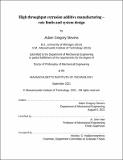High throughput extrusion additive manufacturing – rate limits and system design
Author(s)
Stevens, Adam Gregory
DownloadThesis PDF (12.44Mb)
Advisor
Hart, A. John
Terms of use
Metadata
Show full item recordAbstract
Fused filament fabrication (FFF) is an additive manufacturing (AM) process in which a polymer feedstock is melted and extruded through a nozzle while guided by a motion system, resulting in a three-dimensional part. FFF is applicable across a range of length scales and with a wide variety of thermoplastic polymers and composites. As such, FFF is increasingly used in prototyping, low volume production, and tooling/fixture applications.
One of the drawbacks to FFF is its low build rate, which is limited by the fundamentally serial nature of the process–a single printhead must traverse a trajectory that spans the entire built volume of the part while depositing material. As a result, the build rate is governed by the performance of the motion and extrusion systems. This thesis explores the influence of motion and extrusion system design on FFF build rate by: 1) deriving a set of design rules for FFF systems that maximize rate, subject to specified quality constraints and guided by finite element analyses and parametric models; 2) the mechanical design and construction of a servo-driven FFF testbed that uses a parallel H-frame belt drive; and 3) implementing closed-loop servo control with the aforementioned hardware and assessing axis-level motion performance and overall print quality using test artifacts. Performance of the custom-built FFF system is benchmarked against the models in (1), and against commercial FFF systems, and rate-resolution tradeoffs are quantified. This thesis concludes with suggestions for further machine design and process control improvements for FFF AM.
Date issued
2021-09Department
Massachusetts Institute of Technology. Department of Mechanical EngineeringPublisher
Massachusetts Institute of Technology